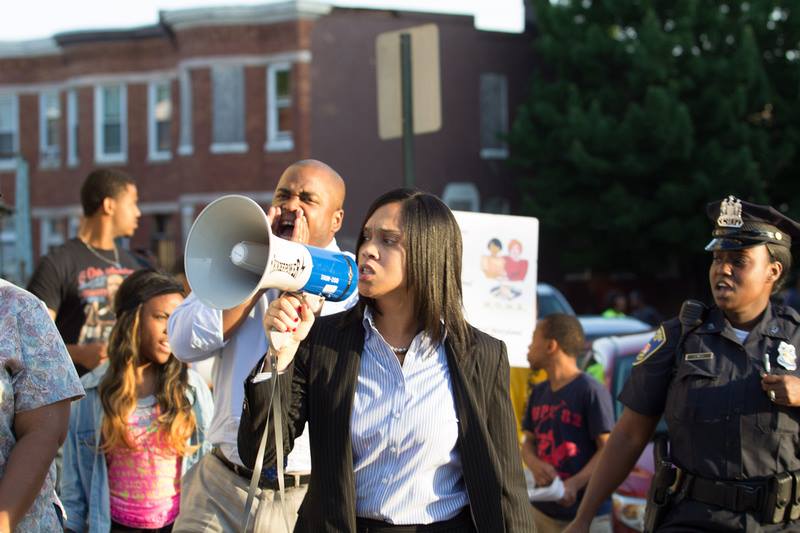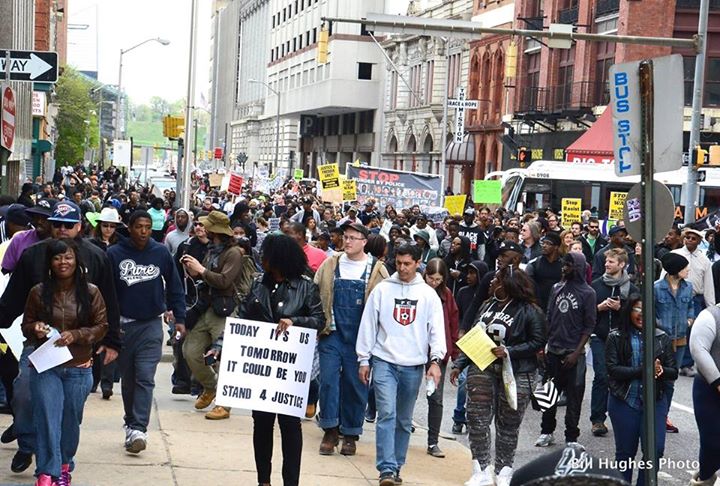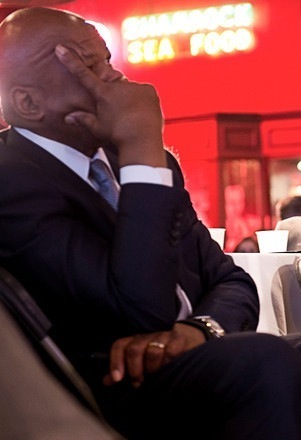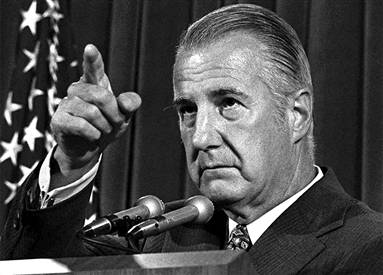
Baltimore City State’s Attorney Marilyn Mosby charged all six police officers involved in the death of Freddie Gray, one with murder. Legal experts believe she over-charged the perpetra- tors in order to pressure at least one of the offi- cers to roll over and testify against the others.
BPD SUPERVISORS AND HIGHER-UPS
LACK TRAINING IN CRISIS MANAGEMENT
The city would be a better place to live in
if the positive activism of protesters
would only carry over into elections
LOOTING, ARSON AND VANDALISM
DISTRACTED FROM KEY ISSUES
AND WAS PAINFUL TO WATCH
By David Maril
No question that State’s Attorney Marilyn J. Mosby’s quick decision to file criminal charges against the six police officers who arrested Freddie Gray, was the most effective path to tranquility after a week of protests and unrest in Baltimore.
The public has been clamoring for answers and a sense of justice regarding the death of the 25-year-old black man who had been arrested, severely injured and died after a week of hospitalization.
It’s vital the charged six police officers have their day in court for the facts to come out and the legal system to have a chance to determine innocence or guilt. The playing field should be level and the same standards enforced whether the accused are civilians or police.
For too many years there is the perception — and there’s little evidence to prove this isn’t true — that blacks and other minorities often are discriminated against by police, locally and nationally.
In this age of smartphone cameras, portable video, and the Internet, the abuse and harassment is more frequently exposed and publicized, raising awareness and stirring public outrage.
The sickening details of Gray’s death is only the tip of the iceberg.
The issue of brutality by a few, but certainly not all, police officers has been a simmering problem for nearly a century and tied in with crisis conditions related to poverty this country struggles to solve.
As someone who remembers, as a kid in 1968, Baltimore’s last riots, following the assassination of the Rev. Martin Luther King Jr., here are a few observations from a week of city unrest:
![]() There’s certainly ample evidence and enough questions to merit police officers going to trial for the death of Gray. Their innocence or guilt will be determined in court.
There’s certainly ample evidence and enough questions to merit police officers going to trial for the death of Gray. Their innocence or guilt will be determined in court.

Protesters march in Baltimore during city’s most violent week since the assassination of Martin Luther King Jr. in 1968. The demonstration shown here was peaceful. (VoB photo/Bill Hughes)
What is lacking here, however, is a trial and judgment for the high-ranking officers at the management level of the city police force who establish the standards and shape the culture and attitudes of the department.
It is unacceptable to me that with all of the publicized incidents around the country in the last few years, of similar types of abuse and brutality, followed by serious public strife, the Baltimore police hierarchy didn’t take effective preventative action.
Mandatory meetings, workshops, seminars, and all types of special training should have been held, accompanied by severe warnings and reminders that law enforcement people are under a microscope. Sloppy, careless and overly-aggressive behavior is now under high scrutiny. It’s no longer business as usual.
One quote that leaves me shaking my head was issued by Michael E. Davey, one of the police union’s lawyers, in Saturday’s Baltimore Sun.
He said, “Let me say in no uncertain terms that Lt. (Brian) Rice and all of the officers involved at all times acted reasonably and in accordance with their training as Baltimore City police officers.”
If any or all of these six officers are found guilty, what about the people responsible for their training and supervision? Where is the accountability at the top?
As more stories continue to emerge about years of “rough ride” abuse in police paddy wagons, outrage against the police department leadership and upper-level management should grow.
The people at the top need to be accountable and shouldn’t be allowed to hide behind the mistakes of lower-level scapegoats they train and lead.
![]() There were a few publicity-seeking outside agitators, who don’t care about Baltimore and will disappear as quickly as national cameras move elsewhere, trying to interject a destructive tone to the protesting.
There were a few publicity-seeking outside agitators, who don’t care about Baltimore and will disappear as quickly as national cameras move elsewhere, trying to interject a destructive tone to the protesting.

Maryland Rep. Elijah E. Cummings was a figure of strength during the week-long demonstrations, urging calm and non- violence as he marched arm in arm with protesters in his West Balto. congressional district. (VoB file photo/Bonnie J. Schupp)
There were, however, a number of impressive local voices who helped steer a positive direction.
Elijah Cummings, congressman from Maryland’s 7th District, was a tireless, soothing tower of strength, staying out on the city streets and preaching for constructive and peaceful protesting.
Catherine E. Pugh, representing Maryland’s District 40 in the State Senate, was also an effective leader.
On local radio, it is hard to match the commentary of WBAL’s Clarence M. Mitchell 4th, for perspective and common sense.
Former Raven Ray Lewis and quite a few members of the current team did meaningful work visiting schools.
![]() The saddest scenes were television video from Monday, April 27th of lootings and the images of burning cars and buildings.
The saddest scenes were television video from Monday, April 27th of lootings and the images of burning cars and buildings.
No matter how justified feelings of frustration and outrage are from years of bigotry, mistreatment and lack of respect, vandalism, violence, and property destruction are detrimental and serve as a distraction from the problems that need correction.
Pharmacies, stores and other businesses are severely needed in these neighborhoods and their destruction makes matters worse, related to employment opportunities and access to food, medicine and other services.
It is difficult to fathom anyone cutting a fire-hose to prevent a building from being destroyed or throwing rocks at firefighters.
![]() Overall, Mayor Stephanie Rawlings-Blake receives a passing, positive grade for her decision-making through this crisis.
Overall, Mayor Stephanie Rawlings-Blake receives a passing, positive grade for her decision-making through this crisis.
She does deserve questioning however for her tardiness, on Monday, April 27th, communicating to the governor that a state of emergency was needed. The presence of the National Guard and more statewide law enforcement sooner might have meant less looting and arson.
However, the mayor overall has been dealing with a complicated and potentially explosive situation and has shown wisdom and judgement setting a restrained, sensible tone for the police to follow.
You have to admire cops who have the discipline and tolerance to stand on the lines and not overreact to those misguided protesters pelting them with rocks. How many human beings are called on to work through those type of conditions?
Other cities and communities around the country have suffered much more damage and violence in these situations because the political leaders had police take approaches that were too militant and aggressive.

Maryland Gov. Spiro T. Agnew ascended to the vice presidency after publicly lambasting Baltimore’s African-American leadership for not doing anything to quell the 1968 riots following the assassination of Rev. Martin Luther King Jr.
During the 1968 Baltimore riots when then-Gov. Spiro T. Agnew made a national name for himself with his lambasting of local civil rights leaders, an estimated 1,000 businesses were destroyed.
![]() Newly elected Gov. Larry Hogan also merits a positive evaluation for his crisis management.
Newly elected Gov. Larry Hogan also merits a positive evaluation for his crisis management.
He added a much-needed get-things-done demeanor and took the appropriate tone assuring there would be security and stability in the city.
While some critics, such as camera-chasing TV personality Al Sharpton, accused him of undercutting Rawlings-Blake when he admitted he wanted to declare a state of emergency earlier on April 27th, he seemed to develop a decent sense of teamwork with the mayor.
![]() Watching the thousands of people who put so much time and effort into marching and voicing their opinions through this protest period makes me wonder why this passion and commitment doesn’t extend into the voting booths.
Watching the thousands of people who put so much time and effort into marching and voicing their opinions through this protest period makes me wonder why this passion and commitment doesn’t extend into the voting booths.
Mosby’s unprecedented rapid decision to file charges against the police officers is a definite sign that politicians and elected officials are very sensitive to public opinion and pressure. But how many of the thousands who spent hours marching and protesting will take a few minutes to vote in elections?
Voter turnout in Baltimore is abysmal, averaging 20 percent.
People have a right to be fed up with lack of quality political candidates. Big money rules the campaigns and the emphasis is on politics instead of leadership and statesmanship.
But when so few people vote, money and political machines control the situation even more. If people mobilize, speak out, get citizens registered and turn out to vote they have a voice and can force positive change.
Politicians, figuring their accountability is only tied to a small percentage of voters, adjust their strategy accordingly. When voting turnout drops down low enough, the will of the people can be supplanted by the power of political machines, fanatics and extremists who can easily swing an election.
If the majority of Baltimore people who marched become inspired to improve the way things are done in government by participating in future elections, the city will be a better place.
davidmaril@voiceofbaltimore.org
“Inside Pitch” is a weekly opinion column written for Voice of Baltimore by David Maril.
CHECK OUT LAST WEEK’S “INSIDE PITCH” COLUMN: click here
…and read archived Dave Maril columns by clicking here.






May 10th, 2015 - 1:39 PM
[…] Voice of Baltimore by David Maril. CHECK OUT LAST WEEK’S “INSIDE PITCH” COLUMN: click here …and read archived Dave Maril columns by clicking here. […]
May 25th, 2015 - 6:36 AM
How refreshing to hear Al Sharpton referred to as a “camera chasing TV personality” rather than an activist. He is more outside agitator than activist. Of the good that comes from Baltimore’s recent tension, perhaps there will be a redefinition of troublemakers like him.